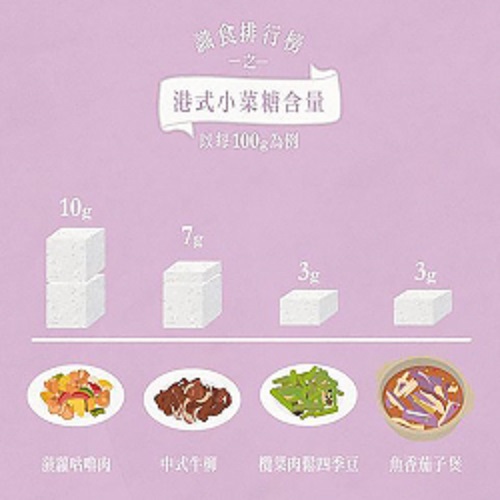
Feature Article
Truths about Nitrate and Nitrite in Vegetables
You will probably know that vegetables are essential components of a healthy diet as they are good sources of dietary fibre, vitamins and minerals and are effective in preventing chronic diseases and cancers. However, some people may have concerns about the health implications of nitrate and nitrite in vegetables. Do we have to worry about that?
Nitrate and Nitrite in Vegetables
Nitrate is widely distributed in nature and can be found in soil, water and food. It is a crucial nutrient for the growth and development of plants. Nitrate can be converted to nitrite naturally and the process is accelerated in the presence of bacteria. In the guts of humans, nitrate can also become nitrite under the influence of metabolism. Apart from vegetables, humans are exposed to nitrate and nitrite from many other sources, such as contaminated water and processed meats (e.g. ham and sausages) using nitrate and nitrite as food additives.
The nitrate contents of vegetables vary among different types of vegetables. In general, leafy vegetables (e.g. cabbage and spinach) have higher nitrate concentrations, whereas the nitrate levels are lower in root vegetables (e.g. potato and carrot) and bulb vegetables (e.g. onion and garlic). The nitrite levels in vegetables are generally low.
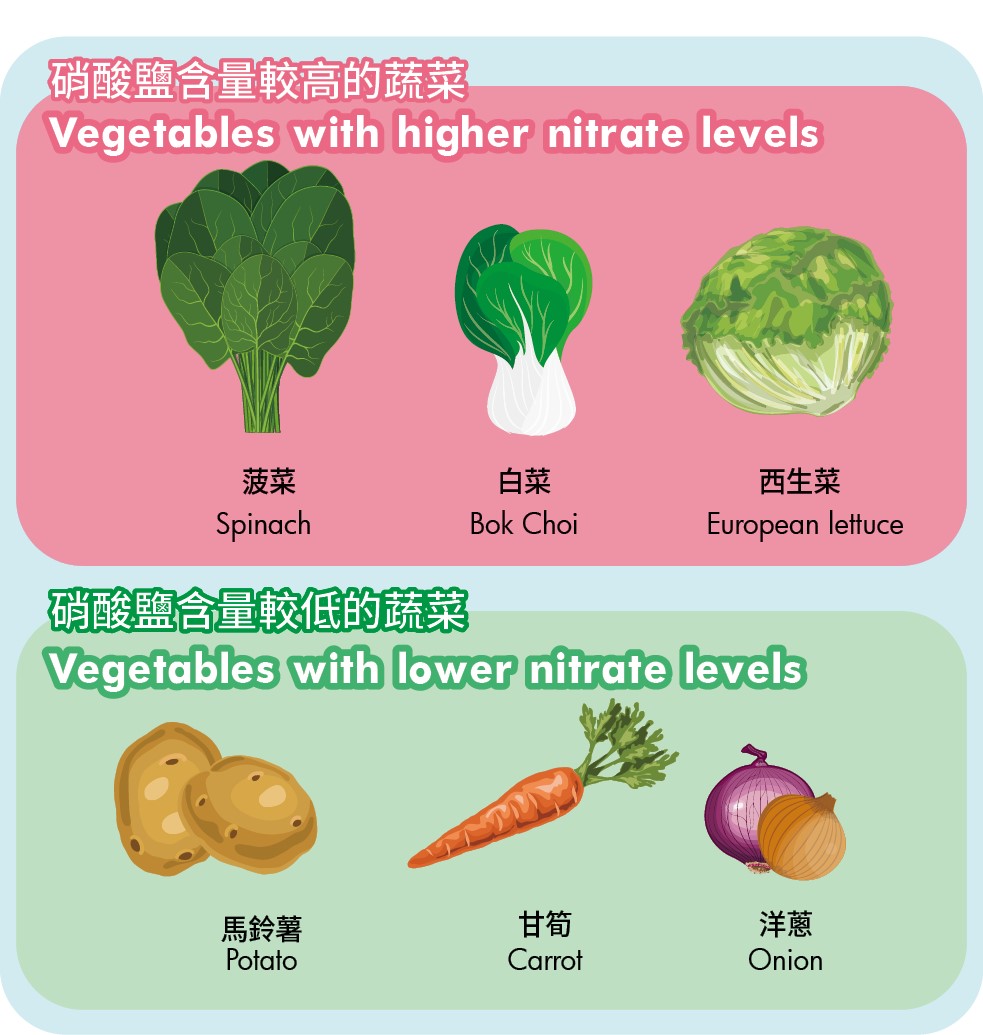
Figure 1: Examples of vegetables with different nitrate levels
Health Implications of Nitrate and Nitrite
Nitrate is relatively non-toxic but its metabolite, nitrite, can trigger oxidation of haemoglobin in blood, rendering it unable to carry oxygen in the human body. This medical condition is known as methaemoglobinaemia. The lips and skin of the affected persons will turn blue. Methaemoglobinaemia is rarely seen in healthy individuals, but infants are more susceptible to it because their digestive systems are immature, which will facilitate the conversion of nitrate to nitrite with the proliferation of bacteria. Besides, foetal haemoglobin in infants is more easily affected by nitrite and it is more difficult to convert the methaemoglobin back to the normal state. This condition is called the “blue baby syndrome”.
Nitrite may also react with amines to form nitrosamines in the human body through endogenous nitrosation. Nitrosamine is potentially carcinogenic in experimental animals, but epidemiological studies do not suggest that nitrate intake from diet is associated with an increased risk of cancer. When nitrate is consumed through a normal diet containing vegetables, other bioactive substances such as vitamin C may inhibit the endogenous formation of nitrosamines. The European Food Safety Authority also considers that the benefits of eating vegetables and fruit outweigh the potential risks to human health from exposure to nitrate through vegetables.
Factors Affecting Nitrate and Nitrite Contents in Vegetables
(1) Food processing
Nitrate is soluble in water. Studies show that the nitrate contents of vegetables will decrease upon washing and boiling due to leaching of nitrate into water. Removing high nitrate-containing parts, such as peeling the skin of potatoes, can also lower the nitrate contents.
Chopping or mashing vegetables will release enzymes that convert nitrate to nitrite in the plant cells, and is likely to cause excessive formation of nitrite. It is advisable to cook vegetables soon after these steps and infant foods such as vegetable puree should be consumed immediately upon preparation.
(2) Storage condition
The nitrite concentrations in fresh, undamaged and well-stored vegetables are usually very low. Studies show that nitrite formation tends to be inhibited under refrigeration as enzymes and bacteria are inactivated. Hence, vegetables are preferably stored in a refrigerator (at or below 4°C) if they are not cooked immediately.
Cooking can stop the enzyme activity in vegetables, but any subsequent bacterial contamination of vegetables can result in nitrite accumulation as nitrate is converted to nitrite by the bacteria. Therefore, if you plan to store cooked food containing vegetables overnight, pack the amount to be stored after cooking but before sharing of the food among diners. The reserved portion should be cooled as quickly as possible and stored in a refrigerator within two hours. We may also consider using root vegetables or bulb vegetables as their nitrate levels are generally lower.
The beneficial effects of vegetables in protecting against cancers and chronic diseases are well recognised. The public should maintain a balanced diet with a variety of vegetables and handle vegetables properly to prevent nitrite accumulation.
Key Points to Note
-
Nitrate and nitrite are naturally present in vegetables and many other foods. High consumption of nitrite may cause methaemoglobinaemia, and infants are more susceptible to its effects.
- Proper food processing and storage are effective in reducing the formation of nitrite in vegetables.
- Available evidence suggests that nitrate intake from diet is not associated with an increased risk of cancer. In fact, eating vegetables is beneficial in preventing chronic diseases and cancers.
Advice to the Public
- Maintain a balanced diet with a variety of vegetables for the benefits of health.
- Handle vegetables properly (e.g. keep them under refrigeration, wash or peel them before cooking, and cook them soon after chopping or mashing). Vegetable puree prepared for infants should be consumed immediately and preferably not be stored at all.
- If you plan to store cooked food overnight, pack the amount to be stored after cooking to prevent bacterial contamination, and keep the stored food refrigerated.
* Unless otherwise specified, the GE levels listed are upper bound values.
Mascot ON in Lesson
Is Air Frying a "Lesser Evil" Than Deep Frying?
The air fryer, introduced over a decade ago, has become an increasingly popular kitchen appliance in Hong Kong in recent years. With its compact size and versatility for preparing a wide variety of dishes, the air fryer appeals to many local households. It is touted as using less oil than deep frying and cooking more quickly than the convection oven, which fits in with the lifestyle and settings of small families.
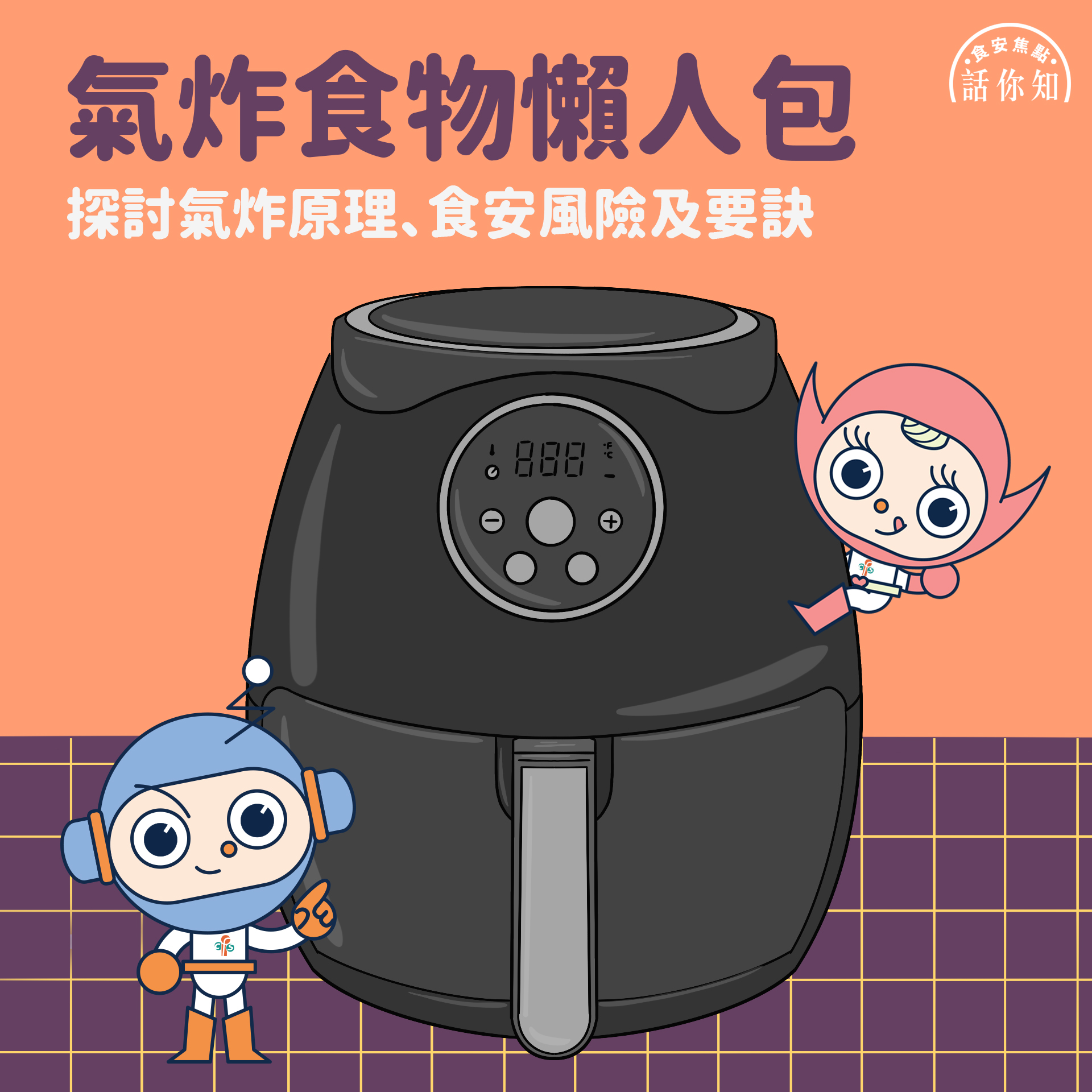
In this issue, we will introduce the principles of air frying and discuss its pros and cons in terms of food safety and the precautions to take for preparing food with an air fryer.
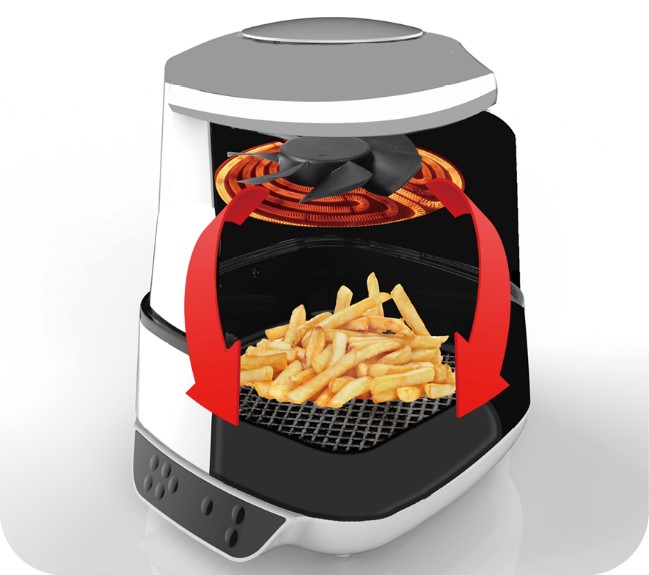
Figure 1: The basic operating principles of air fryers - There is a fan next to the heating element to keep hot air in rapid circulation. Food is kept close to the heat source and oil drips are collected beneath the perforated basket.
How Does an Air Fryer Work?
Albeit its name, an air fryer is actually a small, countertop convection oven. Like a convection oven, it uses a heating element to heat food with hot air circulation aided by a built-in fan. Food is placed close to the heat source in the air fryer and blown by hot air (up to about 200°C) at a high speed. The food is cooked in a perforated basket, which facilitates hot air to move around it. The circulating air will make the food surface crisp without drying out the inside. This cooking process mimics the result of deep frying with little or even no oil applied. Since food is cooked by circulation of hot air in a small, confined space, air fryers will work best when the food is cut into small bits without the pieces overlapping each other.
Is Air Frying a Healthier Way to Cook?
To answer this question, we need to take different aspects of food safety and nutrition into consideration.
Reduced Amount of Fat
As the medium of heat transfer is air rather than oil, oil is often sparingly applied during air frying to enhance the food texture. Besides, any fat-containing juice drained from the meat will be separately collected beneath the perforated basket.
While air frying can reduce a significant amount of total fat in food, it is a kind of dry-heat cooking at high temperatures. It is similar to baking where high-temperature cooking can easily give rise to chemical contaminants like acrylamide and polycyclic aromatic hydrocarbons. The public should be careful with what they choose to eat and maintain a balanced diet with plenty of fruits and vegetables to keep the intake of fat and salt in check.
Formation of Acrylamide During Cooking
Acrylamide is a chemical contaminant resulted from high-temperature cooking. It can probably cause cancers in humans. Acrylamide can be formed in carbohydrate-rich food during air frying at 120℃ or above by the reaction of free asparagine (an amino acid) and reducing sugars like glucose and fructose in the food. A probable human carcinogen with genotoxicity, acrylamide has no safe level for consumption and its level should be kept as low as reasonably possible.
It remains inconclusive whether air frying will produce less acrylamide than deep frying. Although a number of studies find that air-fried potatoes contain less acrylamide than comparable deep-fried ones, a few report no significant differences in the amount of acrylamide formed in both cooking processes. Other factors, including the composition of potatoes or starches used, the surface area of food and the cooking time and temperature, also add to the complexity of acrylamide formation. As a rule of thumb, it is safer to “go for gold” in air frying, that is, to aim for a golden brown or lighter colour when preparing starchy foods like potato, taro and bread and do not overcook them.
Cook Thoroughly and Don't Overload Your Air fryer
We should make sure that food (especially bigger chunks of food) is cooked thoroughly. Moreover, food should be cooked in batches to avoid overloading the air fryer. Attention should be paid to some parts of food that can easily become burnt to avoid the formation of hazardous chemical contaminants. Turn the food occasionally to ensure even cooking and prevent the food from getting burnt. In short, food should be cooked till it is well done but not burnt.
Dining Out
How To Avoid Cross-contamination of Food?
In September 2020, 19 people from 7 groups experienced gastrointestinal symptoms after consuming baked lobsters with E-fu noodles purchased from a restaurant in Tuen Mun. Vibrio parahaemolyticus, a bacterium that lives naturally in sea water, was the causative agent of the food poisoning cases. Investigation revealed that food handlers of the restaurant wore the same pair of gloves in handling raw seafood and cooked ingredients and dried their hands with the towel used for cleaning the work table. Moreover, the same work table was used for handling both raw seafood and cooked food. Cross-contamination was therefore the most likely contributing factor to these food poisoning outbreaks. In fact, cross-contamination is one of the often overlooked but preventable causes of food poisoning.
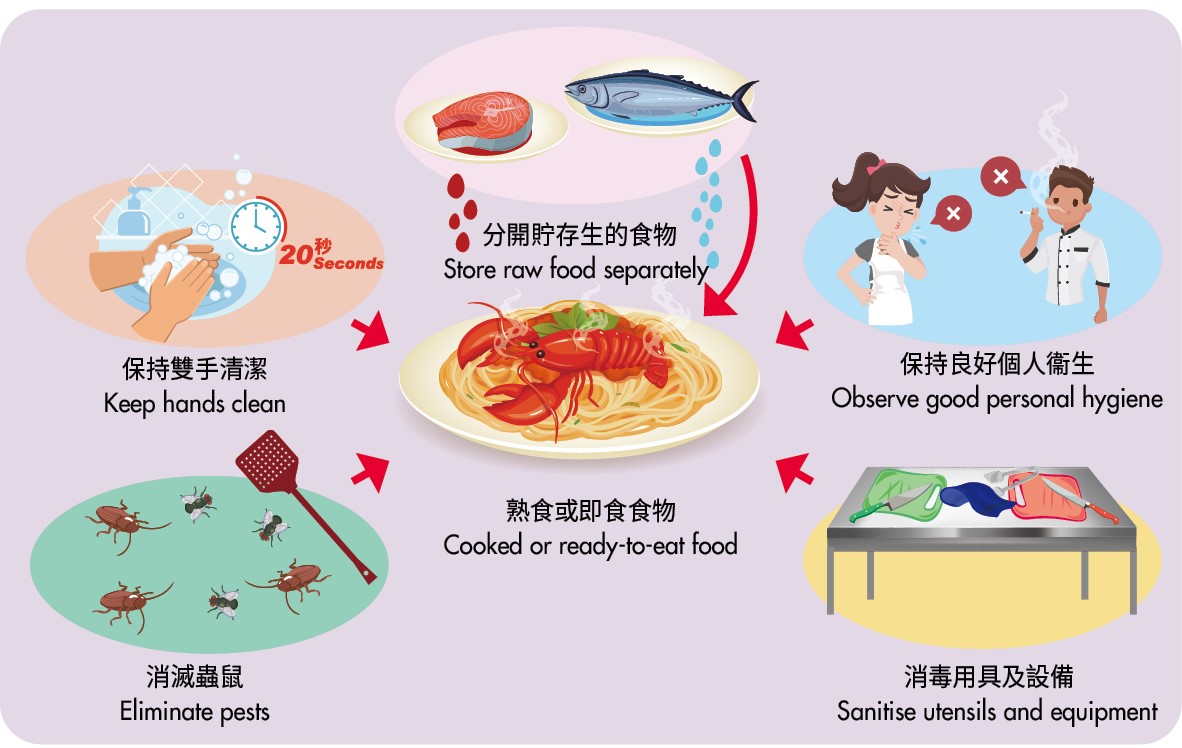
Figure 1: Ways to avoid cross-contamination
Cross-contamination Is a Means of Transmission of Food Poisoning Organisms
Cross-contamination refers to the transfer of microorganisms from one vehicle, such as food (especially raw food), utensils and hands of food handlers, to another food. There are two ways where cross-contamination may occur. On one hand, bacteria can be transferred directly when one food touches or drips onto another. On the other hand, bacteria can be transferred indirectly from contaminated hands, pest droppings, food preparation equipment and utensils, worktops or even splashes to food.
Aggravating Factors
Many food premises in Hong Kong have small kitchens. Tight food preparation areas, coupled with the provision of a vast variety of dishes and an even higher output during rush hours, may lead to slippage in food safety practices during food preparation. This can aggravate the risk of cross-contamination of ready-to-eat food. Despite different constraints, operators of food premises can follow some basic and effective steps to avoid cross-contamination. As the risk of cross-contamination also exists in a domestic environment, the same basic steps should be observed to prevent cross-contamination of food.
Basic Steps to Avoid Cross-contamination
During food preparation, we should always wash our hands thoroughly, especially after touching raw food or its packaging and right before handling cooked/ready-to-eat food. Wash hands with liquid soap and water and rub them for at least 20 seconds. Then rinse hands with water and dry them with a disposable paper towel. Wear disposable gloves when handling read-to-eat food. Gloves should be changed when damaged or soiled, such as after touching raw food. Bear in mind that wearing disposable gloves is no substitute for proper hand hygiene.
Effective cleaning and disinfection of food preparation equipment and cooking utensils is equally important. Work surfaces must be thoroughly cleaned and disinfected before being used for cooked/ready-to-eat food. Wash utensils and worktops with hot water and detergent, especially after preparing raw food.
Furthermore, raw food and cooked/ready-to-eat food in the same refrigerator should be stored separately in covered containers to avoid contact between foods. Store raw food below cooked/ready-to-eat food in the refrigerator to prevent cross-contamination through drippings. To guard against pest contamination, cooked/ready-to-eat food should be stored out of reach from pests.
Key Points to Note
- Cross-contamination is a common and important contributing factor to food poisoning.
- Cross-contamination can occur directly via raw food touching or dripping onto cooked/ready-to-eat food, or indirectly via contaminated hands, pests, work surfaces, food preparation equipment and utensils.
- Cross-contamination is preventable with the application of some basic hygienic practices, whether in food premises or a domestic environment.
Advice to Consumers
- Patronise reliable and licensed food premises and purchase cooked/ready-to-eat food from reliable sources.
- Wash hands before food consumption and after using the toilet.
- Adhere to the "5 Keys to Food Safety" (especially the two keys summed up as "Clean" and "Separate") to safeguard against cross-contamination during food preparation.
Healthy Eating Basics and Smart Food Choices
(1) Rate Your Food: Sugar Content of Hong Kong Style Savoury Dishes
Salt is by no means the sole concern in the consumption of Hong Kong style savoury dishes. The sugar content of food also merits our attention as many Cantonese dishes are prepared with gravies or sauces added with sugar. For example, the popular dish "pork and pineapple in sweet and sour sauce" has 10 grams of sugar per 100 grams of food, while 100 grams of “beef fillet in sweet and sour sauce” contain 7 grams of sugar. If you like Cantonese cuisine and want to eat healthier, you can prepare the dishes at home to better control the amount of salt and sugar in food. For more tips to achieve a healthy diet with less salt and sugar, please visit the Instagram page of the Centre for Food Safety (CFS) at https://www.instagram.com/hkassr/.
(2) Appetizing Recipe - Angel Hair with Basil Leaves in Tomato Sauce
It is getting chilly and we feel like eating more in cooler days. In this issue, we will bring you an appetizing dish "angel hair with basil leaves in tomato sauce". Tomato sauce has a tantalising sweet and sour flavour. It contains less fat and is a healthier food ingredient than the cream sauce. As for basil leaves, they can add flavour to food with a lesser use of seasonings and help reduce salt in our diet. The dish is easy to make. If you would like to give it a try, you can follow the recipe available at the "EatSmart@restaurant.hk" website of the Department of Health at https://restaurant.eatsmart.gov.hk/eng/content.aspx?content_id=1031.
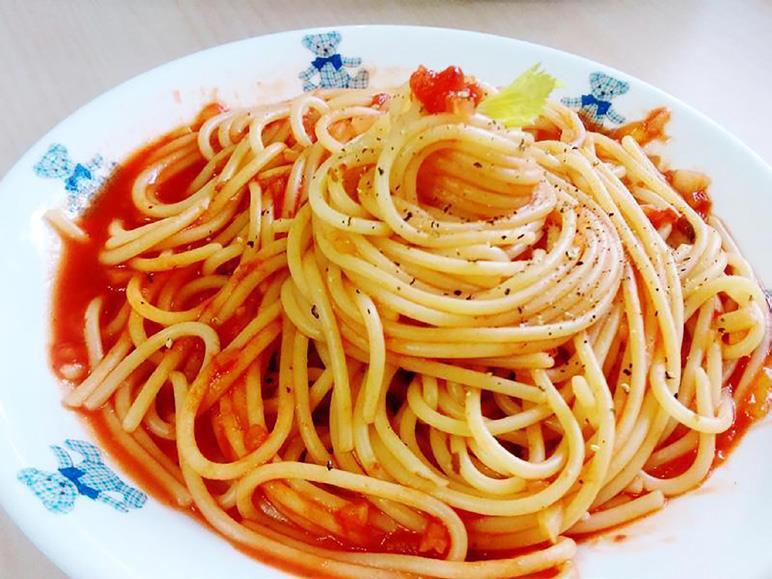
News on CFS
(1) Food Safety App will Cease Operation with Effect from Noon on 31 March 2021
In order that resources for risk communication are allocated more efficiently, the Food Safety App of the CFS will cease operation with effect from noon on 31 March 2021. We apologise for any inconvenience this may cause.
The CFS will continue to disseminate food safety information timely and effectively to the public and the food trade in an interactive and diversified manner through different channels. Please visit the CFS website (www.cfs.gov.hk) or follow our Facebook page (www.facebook.com/cfs.hk) and Instagram page (www.instagram.com/cfs.hk/) to learn about and share updated information on food safety.
(2) "FoodSafe Movie Channel" - A New Online Video Campaign on Food Safety

The CFS has recently launched the "FoodSafe Movie Channel", a brand new online video campaign with the CFS mascots, ON and MUI, sharing food safety topics with the public by hinting at local movies in a humorous manner. Featuring parodies of some well-known movie scenes, the channel is a fun approach for members of the public to gain practical food safety information towards maintaining a safer and healthier diet.
The "FoodSafe Movie Channel", premiered on the CFS YouTube Channel on 7 January 2021, is also broadcast on the CFS Facebook and Instagram pages. We look forward to your support. Please feel free to share these videos with your family and friends.
 |
 |
 |
| CFS YouTube Channel | CFS Facebook Page | CFS Instagram Page |
(3) Less Sugar Friday
Hong Kong people are fond of delicious tea drinks. However, we should be aware that the sugar content of tea drinks vary from one to another. To stay healthy, we should opt for low-sugar beverages. As an incentive for the public to reduce sugar intake, the CFS has launched the "Less Sugar Friday Campaign". Participating tea houses will offer a $2 discount to customers purchasing selected sugar-reduced or sugar-free beverages on designated Fridays.
Please visit the Facebook page of "Hong Kong's Action on Salt & Sugar Reduction" for details.
Information about the participating tea houses can be obtained from the map of Less Sugar Friday available at https://bit.ly/317u7ME.

(4) New Exhibition Boards
The Communication Resource Centre (CRC) of the CFS has recently produced two sets of new exhibition boards on "Nutrition Labelling Scheme" and "Eat Safe! Know Your High-risk Foods", which highlight the local statutory requirements on nutrition labelling and the potential risks of consumption of "raw and cold food" by four susceptible groups (pregnant women, infants, young children, the elderly and immunocompromised persons), with a view to facilitating the public in making safe food choices. The boards are now displayed at the CRC. Free copies of related information leaflets are available for collection. All are welcome to pay a visit to the CRC. The address and opening hours are as follows:
Address: Room 401, 4/F, Food and Environmental Hygiene Department Nam Cheong Offices and Vehicle Depot, 87 Yen Chow Street West, Sham Shui Po, Kowloon
Opening hours: Monday to Friday: 8:45 a.m. to 1:00 p.m.; 2:00 p.m. to 5:30 p.m.
Closed on Saturdays, Sundays and public holidays
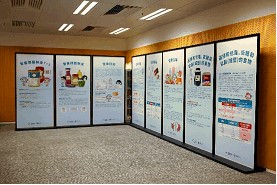
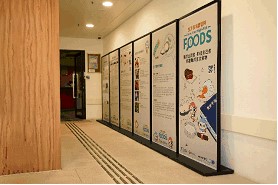
Ask Our Mascots
Do Not Judge an Egg by the Shell Colour

Mandy: Hello, Mascot ON. Are eggs with darker shells more nutritious?
ON: Many people choose eggs with great care. They not only check the shell for cracks and stains but also judge the nutritional value of an egg by its shell colour. Is this an accurate method? Let’s take a closer look.
The colour of an eggshell is largely determined by the chicken breed. Apart from genetic factors, the age of the hen also affects the shell colour. For example, hens that lay brown eggs will produce eggs that are larger and lighter in colour as they grow older. Some people may think that brown eggs are more natural and nutritious than white eggs. Actually, brown-shelled and white-shelled eggs are similar in nutritional value. It is the diets and the habitats of hens which have a greater influence on the nutrition of eggs.
Mandy: Why are egg yolks in different colours then?
ON: The colour of an egg yolk is affected by different factors, such as the pigments in chicken feeds. If hens are given feeds rich in carotenoids, like corns or carrots, they will lay eggs with yolks of a dark orange colour due to the pigments naturally present in these plants.
Mandy: I see. Thank you, ON!
Food Safety Quiz
- Which of the following statements about trans fats is incorrect?
- Hydrogenated vegetable oils are a major dietary source of trans fats.
- Trans fats are required to be listed as a nutrient on the nutrition label.
- Trans fats are a type of saturated fats.
- There is evidence that trans fats raise low-density lipoprotein cholesterol (so-called “bad” cholesterol) levels and lower high-density lipoprotein cholesterol (so-called “good” cholesterol) levels in blood, which is associated with an increased risk of coronary heart disease and other vascular diseases.
- For prepackaged foods labelled with the claim “low sodium”, how many milligrams (mg) of sodium are allowed per 100 grams (g) of food?
- 120mg
- 140mg
- 200mg
- Which of the following is not a correct way of using disposable gloves?
- Wash hands thoroughly before wearing, after removing and when replacing gloves.
- After handling raw food, there is no need to replace gloves before processing cooked food.
- Gloves should be replaced immediately if soiled.
Diary of Mascot ON
Food Fact Checker: Are All Bolete Mushrooms Safe to Eat?
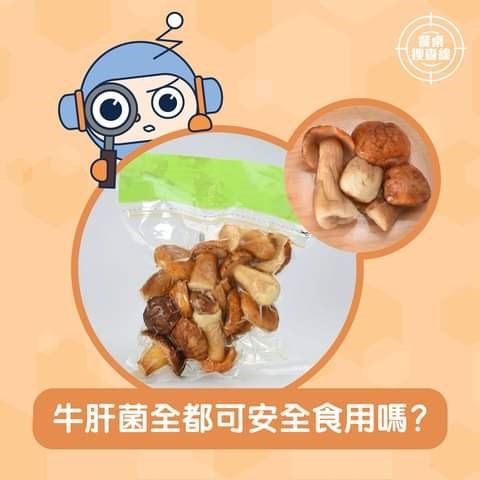
Recently, there was a food poisoning case suspected to be caused by the consumption of bolete mushrooms. As the CFS mascot, I joined the CFS staff to conduct an investigation in the shop concerned and take samples for testing to find out the cause of the incident. As remarked by fungi experts after assessing the samples, the food poisoning case was caused by consumption of boletes containing inedible/poisonous mushrooms.
We should note that bolete mushrooms come in different species. Not all of them are edible and some are poisonous. If people harvest bolete mushrooms from the wild for consumption, they may inadvertently mix edible boletes with other poisonous mushrooms and become poisoned after consuming the mushrooms, which often results in acute cases with the development of gastrointestinal symptoms like nausea, vomiting and abdominal pain shortly after ingestion. Depending on the types of poisonous mushrooms, the affected persons may have other symptoms such as extreme thirst, excessive sweating, coma, hallucination, euphoria and liver damage.
Consumers should buy mushroom products from reputable and reliable shops to ensure that they are safe for consumption. Do not pick and eat wild mushrooms. Avoid purchasing mushroom products that are suspected to contain unknown species of mushrooms, or when the mushrooms appear unhygienic (e.g. with growing substrates on the surface) or show signs of spoilage (e.g. coloured spots, abnormal smell, slime), or when the package has lots of dust or crumbled pieces in it.
Last but not least, seek medical treatment immediately if mushroom poisoning is suspected.
